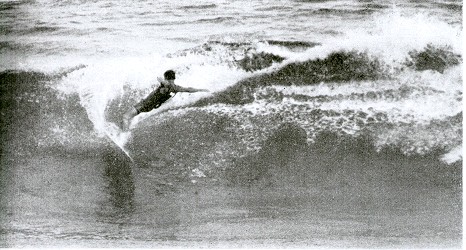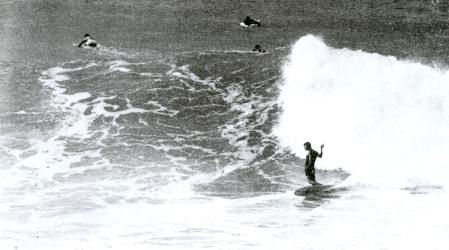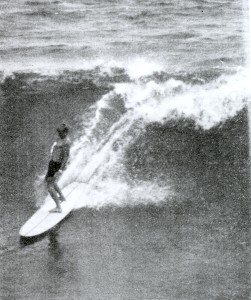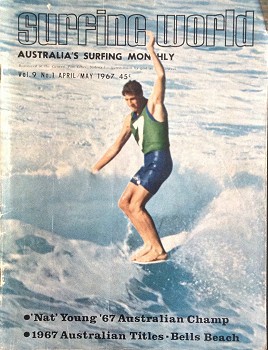
| home | catalogue | history | references | appendix |
 |
surfresearch.com.au
ross kelly : australian titles,
1967
|
For film of the event, see:
Paul Witzig's The
Hot Generation, 1967-1968.
Half a mile from Bells Beach a young Victorian surfer picked up a two way transistor repeating "gate to base. .. gate to base."
A voice at the other end gulped back, "yes!"
"A blue Holden with four guys are coming through without paying."
Before you could say pasturised milk an official car had blocked the road and the admission money collected with peaceful determination.
This then was a scene on Easter Sunday for the grand finals of the week long 1967 Australian Championships.
Tony Olson contest director had the whole place "wired."
Visiting A.S.A. executive officials had long sinte given up advising or suggesting.
There was no need.
Bendy the surf was too good -minds were snapping.
Finalist
Peter
Drouyn later recounted, "We got there about mid-day.
The road
into
Bells was completely blocked by cars waiting to get into the
parking area.
We gave up;
left
the car and walked for nearly 20 minutes past all these cars
and people
... I was really jazzed, I mean all those people."
Some six
months
ago the A.S.A. had successfully convinced the Victorian
branch that a three
round tournament as used in San Diego was the word.
All the
problems
were detailed and eventually one by one removed or reduced.
By February
after
several interstate trips and phone calls, sighs of relief
were breathed
by the contest committee.
The
Victorian
titles used to test many of the ideas were a great success.
It was going
to work.
But Olson
never
let up.
When he ran
oul
of Victorians to harass he rang up Sydney.
(One
interstate
official copped ten calls in one week).
Just about
all
the competitors had arrived by the Sunday before Easter.
Instructions
were given, inquiries answered and last minute
accommodations organised.
Midget
Farrelly,
who had earlier opted out of the contest as a protest
against one-eyed
judging, now wanted to start.
Problem: New
South Wales had no room for him in the team as the vacancy
had been given
to another surfer, and all States had team limits.
The
Victorians
who needed the champ for gate receipts squeezed him in on
the N.S.W. reserve
list by juggling their Vic. drop in options.
And so
everybody
was there.
But that
first
Sunday was lousy surf with on-shore winds that locals said
would stay.
They were
wrong.
Monday and
the
first day's contest, surf spotters reported Bells at six to
eight feet
with slight bounce from the storm and little wind.
Not
perfect, but
bloody good by everybody's standards except some of the
locals.
By
mid-afternoon
the wind freshened from the sea but allowed most of the ...
Page 12
... first
round
Juniors and Womens to be completed.
A semi
repercharge
(made up of 2nd and 3rd place getters in semi finals) and
final for both
decisions were held over for another day.
Back in the beer garden, opinion was that Wayne Lynch, Butch Cooney or Keven Parkinson would take out the Junior trophies with a slight preference at this stage for ''Parko."
Gail Couper
looked
good as usual and without Dorothy Derooy must keep the cup.
Dorothy was
the
only major surfer unable to make the trip.
Her boss the
only holdout.
Hands up
those
who have surfed 10-12 feet hollow walls in glassy water.
(Once again
some
Victorian said it wasn't glassy -"you can't see your face in
the water.")
The mens and senior mens had it all day Tuesday.
Regular
boards
were used by most of the surfers - certainly by the hot
riders.
Brains
popped
as Keith Paul, Peter Drouyn, Robert Brown and Russell Hughes
took off impossibly
inside and made it.
As Conneeley
dropped into mad sections bolt upright doing his unique
fussy foot two
steps.
As Midget on
his super light stick ran the board like it was on fire,
pulled off turns
and cut-backs with such speed and fineness to reaffirm his
position as
master of the shoulder.
As Nat drove
flat boarded across the bowl sometimes with a complete cover
up in the
foam and always with his vicious cut-back.
An ABC
cameraman
Wolf somebody- other related, "I had him (Nat) in frame in
slow motion
on one of those big ones ... the wave completely covered him
up on that
last section.
I panned the
camera back and along the foam to capture the power of the
wave and suggest
the destruction of this surfer - when I reached the shoulder
again out
he popped still on the board, wringing wet."
Nat won the
first
round on a close decision from Midget.
Bob Wilson
cleaned
up the senior mens and at that stage looked an easy winner
for the big
one.
Surprise of
the
day was the foam surfing by aggressive Richard Harvey.
He did not
show
his famous ''fire'' or "over ...
Page 19
... kill"
that
is a legend in Mona Vale.
Local stars Laury Wall, Peter Troy and Rod Brooks could not find the speed when needed ... in Troy's case catching an outside front rail.
That
evening in
the cafes, packed rooms and small groups in the streets
every good wave
was re-ridden.
Then later
the
subject was suddenly dropped.
Attention
was
refocused on beer, raging or sleep.
It had all
been
too much - nothing more could be said.
Next day,
Wednesday,
the remaining events of the first day were run off at Lorne
near the breakwater
in a close-out surf that proved too rude for the girls who
were shifted
back to Torquay beach.
Couper won
in
sloppy three to four foot howling side wind surf.
Beach mate Wayne Lynch niched the 1st round Junior final from Cooney and Parkinson.
Low tide at
Lorne
in a southerly brought up three to five foot good shaped
rights off the
point and some excellent surfing by the girls in this second
round event.
Sydney bird
Christine
Binning spoke for the group - chirping, "Give us good waves
and we will
give you good surfing."
No one
argued,
the point was made.
The juniors shared the surf that day, but no finals were run.
Point Impossible four miles east of Torquay on Good Friday 1967 will be remembered as the scene of a classic surf struggle.
For 45 minutes in the Junior Final (left over from Lorne Point) in five to six foot medium shape surf three small giants - Lynch, Cooney and Parkinson - fought out the most thrilling junior contest ever seen by these tired eyes.
Parkinson threw the first punch with an extended rocking nose stall across falling sections with a couple of his wild cut backs thrown in.
Lynch
followed
with two copy book rides.
Rise up the
wave
on a nose stall- drop down - cut back - drive up high -
re-entry on the
close out - turn left along the foam.
All this must have maddened Butch Cooney who wild bulled his next wave from further inside to out-nose-stall Parko ...
Page 20
... and out re-enter Lynch.
Goofy
footer Lynch,
fighting back, pulled off a six foot re-entry only to tip a
rail up in
the foam. Experts can't remember seeing such a smooth
recovery.
The little
fella
half crouched, grabbed the upturned rail and pushed it back
into position
coming down.
So cool.
The event
see-sawed
back and forth between the three.
The judges
granted
an extension of time.
The P.A. system shouted out to the finalists, "Fifteen minutes extension put up your hand if you can hear and understand."
All hands
shot
up including Butch Cooney's, who at the time was nose
crouching through
a falling six foot section.
Some say he
even
looked back at the beach.
No trouble he made the wave and won the round followed by Lynch and Parkinson.
Gail Couper hit 200 points, but Lyn Stubbins looked good.
Before the whole contest started competitors were told by a message from the judges that three points would come in for special attention: (a) wave selection (b) making the wave (c) bad drop-ins.
This news was treated casually by most competitors, but not for long.
After the first round it became obvious from the judges cards that they were ruthless on drop-ins.
Inside positioning became the name of the game.
Some surfers complained that they were being dropped in on the inside at the take off.
A rule
against
inside dropping in or take off sheperding was considered,
but scrapped.
The problem
solved
itself.
Out in the water exploiters of the new inside caper were conned, during a lull in the sets, into moving their take off spot so far over that when the wave came they could not make it across.
Other
tactics
came in for further development.
Organisers
had
agreed that where possible the best five waves would decide.
This gave
the
consistent surfer an edge over the wild rads.
A controversial point as invariably the decisions from a five wave final runs foul of some beach groups.
Spectators cannot remember more than a few of the waves ridden by each surfer - certainly not five. They are exposed to greater distractions and can afford the luxury of watching the surfers they choose.
And so when a three wave event did show up and enough surf rolled through, surfers would take three or four fast good cape (sic, safe?) rides then move over closer to the rocks and sometimes further out and wait for, at (sic, and?) attempt, the impossible.
Sometimes the surfer made them - always the spectators enjoyed it.
At a special meeting idealist John Witzig claimed incompetence by some of the judges and moved that judges for finals be picked by their so-far results without regard for maintaining a balance from each State.
Supreme
Judge
Cooper countered that Witzig's claim was true in part only,
as all judges
at some stage had goofed.
He was quick
to add that the high and low system had protected the
surfers and that
now all judges were nearly spot on.
The result that forestalled a possible incident was to increase the panel to nine and double the number of high and low scores dropped.
Saturday at Bells in 12 foot medium shape was almost a carbon copy of 1st round Mens and Senior Mens, except most of the top surfers changed over to the bigger boards.
Russell Hughes from Noosa used a radical 9' 10" gun with a pure planing section aft flowing into a 10" pod and 18" fin.
The board
proved
fast and interesting.
Many new
ideas
showed up at Bells.
Bernard
Farrelly's
super light big board with a huge nose lift, which allowed
him to stand
further off the tail and so level and trim the board against
the water
line.
Nat fattened his fins and especially the leading edge to reduce drag, similar to the foil on a dolphin's fin.
The trend
was
for very light thin railed boards, many with nose and back
sections sprayed
for extra feet grip.
(Spectator
McTavish
killed them all by only spraying the middle).
No details
were
overlooked and how ...
Page 21
 |
Bells Beach, 1967. Photograph: Alby Falzon Surfing World
|
 |
Photograph: Alby Falzon Surfing World
|
Page 23
 |
Photograph: Alby Falzon. Surfing World
|
Page 27
... right they were.
If ever you needed everything going for you it was during the last two days at Bells.
The swell
arrived,
more from the south - almost straight in.
The long
drives
on Tuesday were once again attempted against a quicker
falling section.
McTavish
and Conneeley
conned each other over giant close out wall around at Centre
side for four
second thrills.
The Senior
Mens
grand final was won by Malcolm Sanders.
Bob Wilson
on
a board too slow for big Sunday fell back in his placings to
allow Sanders
to win the trophy.
Doc Spence had a ball and won a place with long hard rzil grabbing drives on his big gun.
The juniors
squeezed
value out of the smaller waves that came through, but were
restricted by
the size of the surf.
Lynch won
the
grand final and the trophy.
Whether
level
pegger Cooney could have beaten him if his own board had not
been stolen
will never be answered.
Butch later
said,
"You need confidence out in big surf at Bells ... I wish I
had my own board."
The Mens grand final was good but not the best surfing of the contest.
Nat was too
far
in front.
Farrelly who
had the best chance to catch him tried the hardest, but
never made it through
enough sections.
Spencer and
Brown
sat further out, and inside, than the rest.
Brown went
over
the lot (probably caught the biggest wave of the contest)
but was caught
too often. Spencer was over selective and did not catch
enough waves.
Keith Paul, Robert Young and Peter Drouyn surfed everywhere, and except Paul, anything that came along.
Peter Drouyn won, but it could not have been by much.
It was a
different
Drouyn at Bells.
John Witzig
put
it, "Drouyn never surfed as the brash young kid we remember
... he probably
has a lot more consIstency now in his surfing.
Still, I'll
miss
the brashness."
And so the young Queenslander stepped out off the junior ranks in a bIaze of glory by tossing the champs, but not enough to win THE title which stayed with Nat for another year.
Malcolm Sanders and Jane Farrelly became the first couple to ride big Bells tandem - with a trophy to prove it.
The grand final for the girls was postponed due to the dangerous conditions and run at Point Impossible the next day, with Victoria keeping the cup.
Many things happened at Bells.
Glassy
Tuesday
was the best surf and surfing.
The little
giants
at Point Impossible should be remembered.
Even the
girls
at Lorne proved that they still have the skill but need the
surf.
Maybe the
time
has come for the girls to run their own contests under good
light conditions.
Who knows
they
may even take the bit in their mouth and develop their own
style (I hate
that word) and contest rules.
Feminine
surfing
as often seen in Lynda Merrill and sometimes in Byron Bay is
a new and
unexplored world.
The N.S.W. surfers won't have it so easy next year now that the other states have seen their secret weapon of foam control.
They have 12 months to sharpen their rails and enter the world of roller coasters, re-entries, pure trim and pocket picking.
Some events
were
so hot and the surfing so deep that at times the
competitors' abilities
passed a judge's understanding.
Or was it
fatigue
or that great disease inferiority complex which forces a
judge's wave assessments
out of the top and low levels into the safe centre.
Top surfers
are
dud judges.
To be on top
they must and do believe with strength that their way is the
right way.
The solution used at Bells was a good one and the panel drawn from every State with experience either practically or emotionally with a series of built-in safe guards.
Few restrictions were placed on competitors and a minimum of "correct surfing" advice given.
If winners
are
decided by yardsticks and detailed requirements, competition
surfing becomes
a sport.
If it can be
judged emotionally by a panel under minimum restrictions it
is an art form
- and Bells was close to art.
 |
Bells Beach, 1967. Photograph: Alby Falzon. Surfing World
|
 |
Bells - as tolled by Ross Kelly. Surfing World Volume 9 Number 1 April-May 1967, pages 10 to 27. |

| home | catalogue | history | references | appendix |